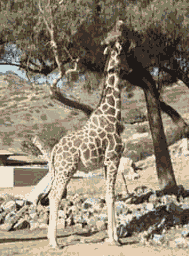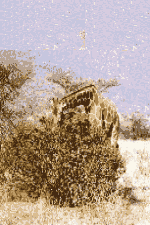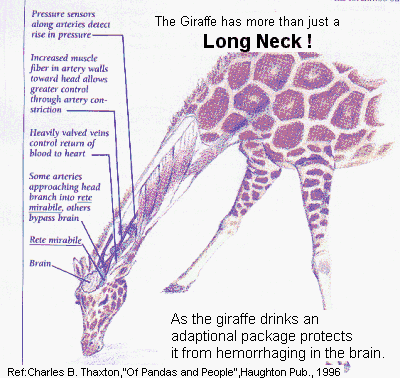"The Tallest Tale is the textbook version of giraffe evolution -- a bit of a stretch." So began an article by Stephen Jay Gould. (ref: "The Tallest Tale" by Stephen Jay Gould, Natural History, May 1996)
"I raise this theme because I recently realized that the primary "old standard," the classic textbook illustration of our preferences for Darwinian evolution, arose in the same manner as an entrenched and ubiquitous example based on an assumed weight of historical tradition that simply does not exist...I made a survey of all major high-school textbooks in biology. Every single one -- no exceptions -- began its chapter on evolution by first discussing Lamarck's theory of the inheritance of acquired characteristics, and then presenting Darwin's theory of natural selection as a preferable alternative. All texts then use the same example to illustrate Darwinian superiority -- the giraffe's neck." (pp. 18-19)
"Giraffes, we are told, got long necks in order to browse the leaves at the tops
of acacia trees, thereby winning access to a steady source of food available to no
other mammal. Larmarck, the texts continue, explained the evolution of long necks
by arguing that giraffes stretched and stretched during life, elongated their
necks in the process and then passed the benefits along to their offspring by
altered heredity."
"This lovely idea may embody the cardinal virtue of effort rewarded, but heredity,
alas, does not operate in such a manner. A neck stretched during life cannot
alter the genes that influence neck length and offspring cannot reap any genetic
reward from parental striving." (pp 19-20)
"If we choose a weak and foolish speculation as a primary textbook illustration (falsely assuming that the tale possesses weight of history and a sanction in evidence), then we are in for trouble as critics properly nail the particular weakness and then assume that the whole theory must be in danger if supporters choose such a fatuous case as a primary illustration." (p. 56)
"In the realm of ideas, current use of the giraffe's neck as the classic case of Darwinian evolution does not grow from firm and continuous historical roots. The standard story, in fact, is both fatuous and unsupported...Why then have we been bamboozled into accepting the usual tale without questioning? I suspect two primary reasons, we love a sensible and satisfying story and we are disinclined to challenge apparent authority (such as textbooks)." (p. 57)
His conclusion is:
..."but if we continue to illustrate our conviction with an indefensible, unsupported, entirely speculative and basically rather silly story, then we are clothing a thing of beauty in rags and we should be ashamed, "for the apparel oft proclaims the man." (p. 57)


In their article, "Winning by a Neck," zoologists Robert Simmons (Uppsala University) and Lue Scheepers (Ministry of Environment, Namibia) agree with Gould that the standard account "may be no more than a tall story". According to the competition hypothesis, giraffes use their long necks to advantage during dry seasons, when food is scarce; but, in fact, the opposite is observed in the field. "In the Serengeti," Simmons and Scheepers note, "giraffe spend almost all of the dry season feeding from low Grewia bushes, while only in the wet season do they turn to tall Acacia tortillis trees, when new leaves are ...plentiful ...and no competition is expected. This behavior is contrary to the prediction that giraffe should use their feeding height to advantage at times of food scarcity". Moreover, they report, "females spend over 50% of their time feeding with their necks horizontal [a behavior so common it is used to determine the sex of animals at a distance]" and "both sexes feed faster and most often with their necks bent". These observations, they conclude, suggest "that long necks did not evolve specifically for feeding at higher levels." (from http://www.arn.org/ docs/odesign/ od181/ls181.htm)

